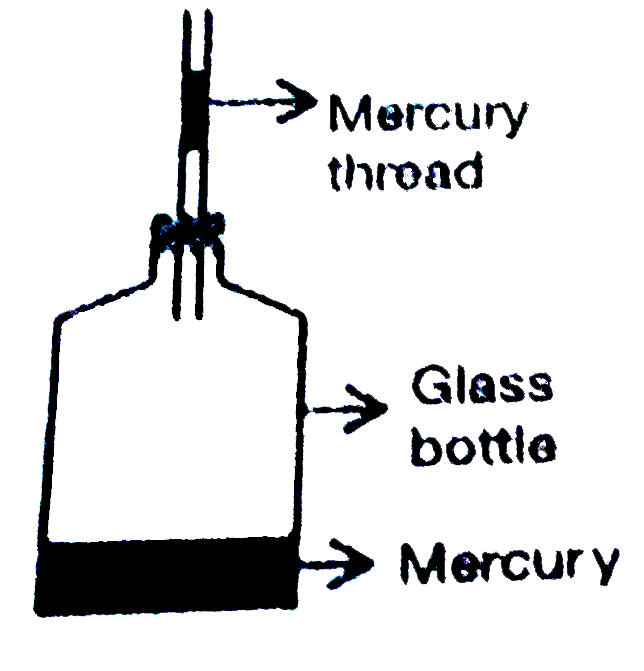A constant volume air thermometer is as shown in the figure below. Explain why the bottle is partly filled with mercury. Find the ratio fo volume of mercury present in the bottle to the volume of the bottle if the volume coefficients of mercury and glass are 1.8×10−4K−1and6×10−5K−1, respectively.

(i) Given the two metal cylinders are of the same material. Their specific heat capacity and ensity are the same. In the equation Q=msΔthea, express mass in terms of volume and density.
Volume of a cylinder =πr2l, where 'r' and 'l' are its radius and length, respectively.
Given heat supplied to both the cylinders is equal, ⇒QA=QB.
Ratio of the lengths and ratio of the radii of the cylinders is given. Hence, from the above equation, find the ratio of the rise in temperatures of the cylinders.
2:1
Topper's Solved these Questions
Similar Questions
The relative density of mercury is 13.6. Find the ratio of the mass of mercury of a certain volume to that of water having ten times the volume of mercury.
View SolutionThe realtive density of mercury is 13.6. Find the ratio of the mass of mercury of a certain volume to that of water having ten times the volume of mercury.
View Solution
Knowledge Check
The remaining volume of a glass vessel is constant at all temperature if 1x of its volume is filled with mercury. The coefficient of volume expansion of mercury is 7 times that of glass. The value of x should be
A5B7C6D8
The volume of a glass vessel is 1000 cc at 20∘C. What volume of mercury should be poured into it at this temperature so that the volume of the remaining space does not change with temperature? Coefficients of cubical expansion of mercury and glass are 1.8×10−4C−1 and 9.0×10−6C−1. respectively.
View SolutionThe volume of a glass vessel is 1000 cc at 20∘C. What volume of mercury could be poured into it at this temperature so that the volume of the remaining space does not change with temperature? Coefficients of cubical expansion of mercury and glass are 1.8×10−4∘C−1 and 9×10−6∘C−1 respectively.
View SolutionThe volume of a glass vessel is 1000 cc at 20C. What volume of mercury chould be poured into it at this temperature so that the volume of the remaining space doed not change with temperature? Coefficients of cubical expansion of mercury and glass are 1.8 xx 10^(-4) o^C(-1) respectively.
View SolutionA glass flask with volume 200 cm3 is filled to the brim with mercury at 20∘C. How much mercury overflows when the temperature of the system is raised to 100∘C? The coefficient of linear expansion of the glass is 0.40×10−5K−1. Cubical expansion of mercury =18×10−5K−1.
View SolutionA glass flask with volume 200 cm3 is filled to the brim with mercury at 20∘C. How much mercury overflows when the temperature of the system is raised to 100∘C? The coefficient of linear expansion of the glass is 0.40×10−5K−1. Cubical expansion of mercury =18×10−5K−1.
View SolutionThe remaining volume of a glass vessel is constant at all temperature if 1x of its volume is filled with mercury. The coefficient of volume expansion of mercury is 7 times that of glass. The value of x should be
View SolutionA glass vessel of volume 100cm_3 is filled with mercury and is heated from 25oc to 75oc.What volume of mercury will overflow? Coefficient of linear expansion of glass=1.8×10−6c−1 and coefficient of volume expansion of mercury is 1.8×10−4C−1.
View Solution
